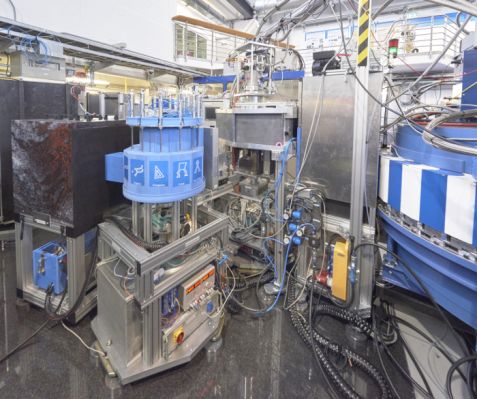MLZ is a cooperation between:
 > Technische Universität München
> Technische Universität München > Helmholtz-Zentrum Hereon
> Helmholtz-Zentrum Hereon
 > Forschungszentrum Jülich
> Forschungszentrum Jülich
MLZ is a member of:
 > LENS
> LENS > ERF-AISBL
> ERF-AISBL
MLZ on social media:

MLZ (eng)
Lichtenbergstr.1
85748 Garching
5.8.2016
Software TAKIN makes scientists’ life easier

At the three-axis spectrometer MIRA, the new software has been tested and is now available to users. The instrument itself is characterized mainly by its excellent momentum and energy resolution. © W. Schürmann / TUM
According to Wikipedia, a TAKIN is a goat-like mammal in Asia. Quite different at FRM II: here it is a new and extremely useful software that Tobias Weber, Robert Georgii and Prof. Peter Böni of the MIRA group developed specifically for working with three-axis spectrometers.
Three-axis spectrometers are standard instrumentation of neutron sources and are highly frequented everywhere. They are often used to deeply study the various phenomena of magnetism, lattice dynamics or subatomic processes in superconductivity. However, the work with these instruments is not trivial at all and very few users exactly know how the results were produced. Therefore, the use of a three-axis spectrometer requires a lot of support from the local scientists who take care of the instrument.
A major difficulty is the very complex resolution function of the instrument. Without precise knowledge of this function a scientist holds “ghost peaks” for real and cannot even plan his experiments conclusively.
Tobias Weber wanted to find a remedy: “So far there have been isolated applications, but no software that can be used on all three-axis spectrometers and is in addition easy to use”. The software program TAKIN solves this problem: It guides users through all the steps that are necessary for the experiment planning, and can easily be adapted to all standard three-axis spectrometer. The most important feature is the fully integrated graphical interface. After entering the instrument parameter a graphical representation of the lattice is displayed, which can be changed now via mouse. Moreover, TAKIN communicates with the instrument control system NICOS and can display the spectrometer’s position and resolution live. It even warns the user when “ghost peaks” can appear by a particular instrument constellation, which would falsify the result. “Our software will make the users of three-axis spectrometers life easier and improve the results of their experiments”, the authors are sure. They published a detailed description in the open-source journal SoftwareX: https://dx.doi.org/10.1016/j.softx.2016.06.002
Original publication:
SoftwareX: https://dx.doi.org/10.1016/j.softx.2016.06.002
MLZ is a cooperation between:
 > Technische Universität München
> Technische Universität München > Helmholtz-Zentrum Hereon
> Helmholtz-Zentrum Hereon
 > Forschungszentrum Jülich
> Forschungszentrum Jülich
MLZ is a member of:
 > LENS
> LENS > ERF-AISBL
> ERF-AISBL
MLZ on social media:


